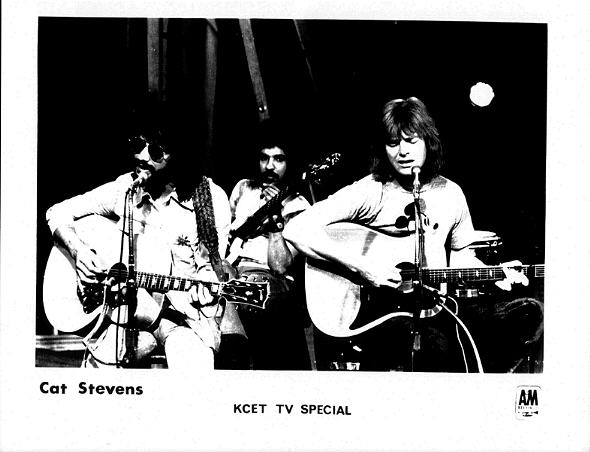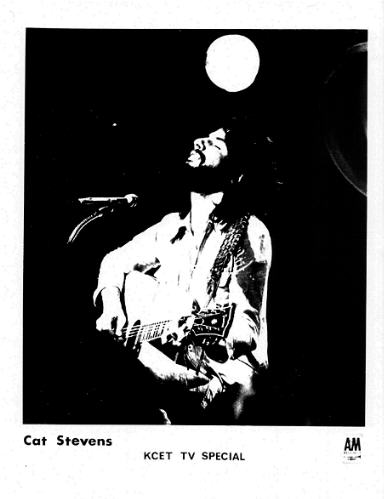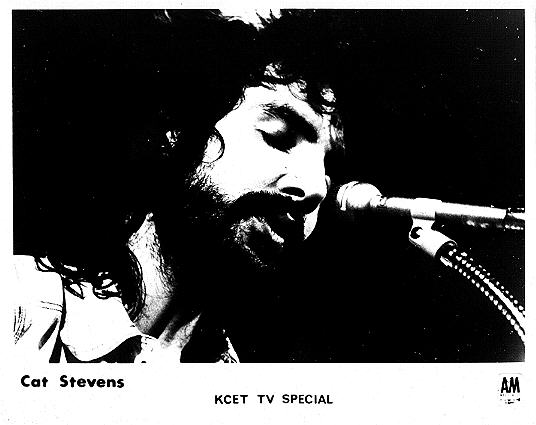KCET - PBS 'Full Circle' TV Concert
- News Release and Promo Photographs
from A & M Records
- This is the press release that was issued
by A&M Records and sent to radio stations across the country.

- NEWS FROM A&M RECORDS
- 1416 NORTH LA BREA AVENUE,
HOLLYWOOD, CALIFORNIA 90028 TELEPHONE 461-xxxx
- CAT STEVENS
(A Biography)
A&M’s Cat
Stevens is one of the biggest and most genuine writing performing talents of our time. Not
a press agent’s statement of dream, but a pure statement of fact which has been oft
repeated by sources a lot more independent and objective than we could ever claim to be.
"Best" Magazine, Paris, described him
as "one of the most important artists of the 20th Century". The Evening News,
London, described his on-stage performance at Fairfield Hall, Croydon in December; 1970 as
"pure magic". The "LA Free Press" review of his first album,
‘Mona Bone Jakon’ said that Cat Stevens was one of the few people in the world
capable of creating a total new world in which you can believe.
At the Fillmore East, New York, his first American audience stood
and cheered him into three encores when he finished an hour-long set of his own songs. A
few weeks later he caused five nights of euphoria when he played The Troubadour in Los
Angeles to capacity crowds.
He’s had rave reviews for albums and
concerts in every major publication from San Francisco to Stockholm via Scunthorpe,
England and Sydney, Australia.
He’s already
finished the music score for one major movie production (Jane Asher’s "Deep
End"), and has almost completed a musical fantasia "Revolussia", from which
his English hit single "Father and Son" was taken.
His two A&M albums released so far,
"Mona Bone Jakon" and ‘Tea for the Tillerman" have not had anything
remotely resembling a so-so review from anyone.
Cat Stevens was born July 1948, in the
Hammersmith area of London. The second son of a Greek-born father and a Swedish-born
mother, he grew up in the hectic atmosphere of central London, where his parents still own
and run a bustling restaurant. "The Moulin Rouge".
A complete 20th
Century child, he went to school in London’s West End, and grew to accept the sight
of strippers running from club engagement to club engagement, to non-stop traffic, to air
pollution (until the anti-smog legislation of the 1950’s), to miles of neon, to the
complete absence of wide open spaces, and to being one tiny part of a huge whole.
After finishing his basic schooling (he hated it,
and did only moderately well at everything except Art - his first love) he was accepted as
a student at Hammersmith College of Art.
During his one-year stay there, he started
writing his own songs after realizing that his solo versions of the current hits were
verging on the ludicrous. He played his songs to friends who liked them, and then, as fate
would have it, he was "discovered".
His patron was a businessman, complete with a fat
cigar, who hooked his index finger at the young boy and said, as true as I’m here
telling you all this, "I’m gonna make you a star."
The initial intention was that the 17 year-old
artist would work in movies, but a number of things happened which changed all that.
The first was that Mike Hurst, formerly one third
of the highly-successful Springfields (with Dusty and her brother Tom), and then the new
bright producing light at Decca Records, heard a tape Cat Stevens had done of a couple of
his own songs.
He liked them and fixed up an elaborate
demonstration session, the results of which were taken to Dick Rows, head of Decca’ s
a-and-r department.
Dick Rowe loved what he heard, and before you
could say: "Sign on this line, son!" Cat Stevens had signed on this line, and
was launched on Decca’s new Deram label.
Pretty soon Cat Stevens was a Star, with the very
big and heavy Agency working for him (the businessman had meanwhile departed to make
further discoveries and has not been heard of since in the music world), a whole wardrobe
of the neatest, trendiest, mage-making and sharpest clothes you could imagine, and the
Machine took over.
All this could have been for the good had Cat
Stevens himself had any control over the situation. But the small print in his contracts
made it very clear that he was a product.
Consequently, although he had a number of very
big hits and was an Idol, Cat Stevens started to fret. Desperately unhappy and brought
down because all his own wishes were studiously ignored or thrown out (like his plan to do
a very simple, solo LP without the usual 90-piece orchestra crashing out the obligatory
leaden arrangements which he was told was both fanciful and artistically suicidal).
"I used to dread recording sessions he
recalls. "For days before, I’d spend sleepless nights fearing having to walk
into that studio and face a mass of blank, uncomprehending and unsympathetic session men
who would go mechanically through their chore, put down a technically perfect but totally
antiseptic recording of my music, and then drift off into the next session for the
guy."
And because he was unhappy, and because his
agency told him he had to do this concert tour, or appear on that TV show, he drove
himself into the ground and got very, very sick.
So sick that when he went to his doctor for a
check-up he was told that one lung had collapsed, and that the other was in real danger of
following suit.
The case was simply stated. Go into the hospital
now, for a long curative rest, or face the real possibility of dying within a couple of
years. He had contracted TB.
 So, with his record player and few albums, a lot of books and a heavy
heart, Cat Stevens packed himself off to a sanitarium in the country. So, with his record player and few albums, a lot of books and a heavy
heart, Cat Stevens packed himself off to a sanitarium in the country.
With six months to relax and think about himself
Cat Stevens set about getting himself straight. He got into Yoga, into metaphysics
generally, did a lot of introspective thinking and wrote a whole lot of new songs, which
reflected his true feelings at the time. A lot of them ultimately became the tracks on
"Mona Bone Jakon".
His contract with Decca, meanwhile, had expired,
and although he was asked to resign with them at an increased royalty rate, he declined,
figuring he could make out somehow, somewhere else.
On his release from the hospital, Steve went away for a
time to recuperate his strength, and did some rough versions of his new songs on his home
tape machine.
One of the people he played them to was Chris
Blackwell, head of Island Records, who offered him the chance to record them whenever and
with whomever he liked. Also, and this was most important as far as Cat Stevens was
concerned, however he liked.
So, when he had completed writing the material
for "Mona Bone Jakon" he sat down with Chris Blackwell and signed with his
label.
Gradually, with a few hand-picked musicians and
producer Paul Samwell-Smith, Cat Stevens recorded the album, and it was released in the
early months of 1970, almost 18 months since his last record offering.
(It was released on A&M in the States and on
Island in England.)
It was an
unqualified success, both artistically and financially. A single from the album,
"Lady D’Arbanville’ made the British, French, Dutch, Swedish, Italian and
German top ten singles charts, the album itself made No. 1 in France, got very high in
Holland and Germany, and concerts he gave in those countries were sold out weeks before
the day.
As a result of the response to "Mona Bone
Jakon", Cat Stevens flew to Paris where he was presented in solo concert in a
35-minute TV special, networked nationwide.
Playing a few selected club and concert dates, he
soon established himself as a much-demanded "live" performer in Britain. The
climax of his summer work came when he blew all the other name acts off-stage at the
Saturday afternoon concerts of the 1970 Plumpton Jazz Festival.
The Cat was well and truly back.
With "Mona Bone Jakon" under his belt
and a great deal of confidence in himself restored, Cat Stevens got down to work again
with Paul Samwell-Smith.
The result was his second album "Tea for the
Tillerman‘, which was released in Britain and Europe in October ‘70, and in
America on A&M a few weeks later.
Two weeks after
release, it zoomed to No. 23 in the British album charts, sold twice as well as
"Jakon", and followed its predecessor up the European album listings.
Reviews for
"Tillerman", which featured a beautful cover painting by Steve based on the
title song, were every bit as good as those for "Jakon".
If anything they were better, because a lot of
people who had given it cursory attention because of the past musical history of the
artist as a young man, suddenly realized just how amazing this talent was.
After completing a series of concerts in Britain
Cat Stevens embarked on his first trip to the States.
On Wednesday, November 18, 1970, Cat Stevens
stepped, for the first time, onto an American concert platform. He faced one of the
toughest audiences in the world - that of a Fillmore East packed house who had come to
see, not him, but headliners Traffic.
At the end of his set, Cat Stevens received a
standing ovation and was brought back for three encores.
He repeated his success at every show he did on
the East Coast, including a residency at The Gaslight, New York. Then he went West, and
played a brilliant week at The Troubadour, Los Angeles.
Back to England for Christmas, he rested for a while after doing
his first solo concert in London area at Fairfield Hall, Croydon. He had the capacity
audience eating out of his hand within four bars of his opening number, and Christmas,
1970 was subsequently a very happy one for the family at "The Moulin Rouge."
# # ## # # # # # # # #

top of page |